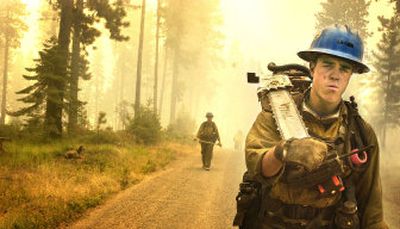‘Last stand’ to ring fire

POMEROY, Wash. – Firefighters launched a massive assault on the School fire Wednesday, hoping to girdle the blaze with fire lines before it can make a run for a maze of steep canyons in a roadless wilderness about two miles south of the current burn.
The effort was described as a “last stand,” by Stan Hinatsu, a spokesman for the interagency team leading the team of 1,600 firefighters. If the fire manages to continue its run to the south, “hundreds” of additional cabins and homes could be at risk, said Incident Commander Bob Anderson.
“It would open up a huge landscape,” he said.
Hundreds of firefighters worked to widen protective fire lines around at least 50 cabins inside the burn area, as well as fire lines that have been dug around three sides of the 43,000-acre burn area. Small progress was made, but the fire is nowhere near being collared, Anderson said.
“This fire is far from a dead duck. The remaining containment is in the toughest piece of real estate we’ve got,” he said, adding that the fight was focused on the southeast and southwest corners of the blaze. “If we can hold those corners, it allows us to build a line across the southern perimeter. So far they’re holding.”
At least 49 cabins and 38 outbuildings have already been destroyed since the fire started Saturday when a branch fell onto a powerline in the School Canyon area about 15 miles south of Pomeroy. Fire officials expect the number of burned homes to rise as crews have more time to inspect the damage. No additional cabins were destroyed Wednesday.
Elsewhere in the state, lightning was a problem in north central Washington, where at least two new fires were started by a storm that blew through the region Tuesday night.
Three other ongoing fires, one 21 miles southeast of Tonasket, one 18 miles northwest of Leavenworth and another near Cle Elum, all were at least 70 percent contained by Wednesday.
A fire in northern Lincoln County threatened 20 homes Wednesday evening. The blaze, about seven miles northeast of Davenport, had grown to about 1,000 to 1,500 acres by nightfall, said Steve Harris, Department Natural Resources spokesman. The state was scheduled to take over management of the fire Wednesday night. Firefighters were called to the scene at Green Canyon and Level roads about 3:30 p.m.
In Idaho, about 20 homes outside of Grangeville were evacuated because of the 500-acre Blackerby fire.
About $3.6 million has been spent fighting the School Fire south of Pomeroy, which is considered the largest and most destructive in the nation.
Crews used shovels, chain saws and Pulaski tools to widen protective fire lines around dozens of cabins in the Rose Springs area, said John Holcomb, who directs the firefighting efforts for the eastern half of the fire. He spent much of Wednesday afternoon less than a mile from the fire line, poring over maps spread across the hood of his Dodge pickup and coordinating the movements of hundreds of men, women and machines. The advancing flames prevented much work from being done near cabins in the Stentz Springs area, he said.
All along the southeastern edge of the fire, crews cut trees lining a forest road, which served as a fire line. The road needed to be widened to boost chances that flying embers or tall flames could not jump across. Miles of the road were lined with small pine trees firefighters described as “dog hair thick.”
After the stands were thinned, crews walked the edge of the road, spilling flaming kerosene from drip torches onto dry tinder. This created a belt of blackened ground next to the road at least 50 feet wide in places. A burning ember could still float across those 50 feet, but every extra foot burned free of tinder and grass boosted the chances of starving the fire.
As Holcomb explained the operations, thick smoke in the air began to clear, revealing a crisp blue sky. This would make flying helicopters and air tankers easier, but the weather change also indicates that the fire would soon gain strength, Holcomb said. The blanket of smoke kept things relatively quiet. When the sky cleared, the fire roared to life as if a damper on a fireplace had opened.
“This is the bewitching hour,” Holcomb explained.
Minutes later, the sound of planes and helicopters filled the area. The aircraft were dumping chemical retardant near the cabins, hoping to cool the advancing wall of flames. It seemed to be working, Holcomb said.
“Today’s a big day. If we don’t stop it here, it gets into country that’s really tough,” Holcomb said.
Less than two miles south of Holcomb’s position was the Wenaha-Tucannon Wilderness Area. There are no roads in the federally designated wilderness and laws prohibit the use of bulldozers or other firefighting equipment there.
Downwind from the fire, ash fell like snowflakes. Parked firefighting vehicles all had their windows rolled shut to prevent flying embers from landing inside. The sun was nearly blocked out, casting a gray light over the blackened forest. Some areas resembled a World War I battlefield.
The Baker’s Pond area, where most of the cabins burned, was littered with twisted sheet metal and other traces of the former homes. A melted satellite dish. Door hinges in piles of ash. Strips of metal roof 30 feet into pine trees. Rivers of molten lead from vehicle batteries shining brightly against the black charcoal ground. Metal skeletons of lawn chairs. A ladder. Everything was slightly contorted by the blast furnace power of the blaze, which rolled through the area Saturday night.
Small birds fluttered through the blackened branches, picking pine nuts from cones that were blossomed open by the fire’s heat.